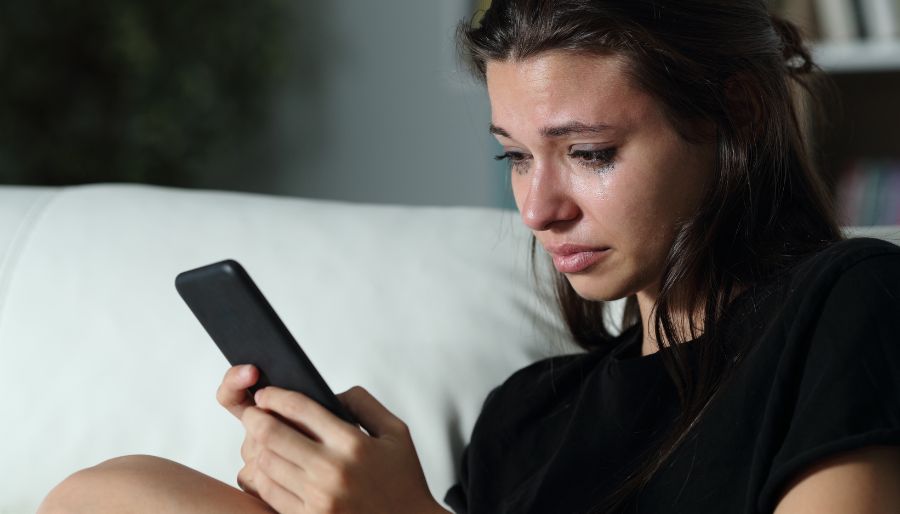There’s no question that children that are being bullied at school are also experiencing high rates of cyberbullying. The NSW Government found that 84% of children who are bullied online were also bullied in person. So, with the majority of school assault and bullying claims now including online activity, what role does your child’s school play in mitigating it, and can they be sued for not protecting your child?
Firstly, if your child is experiencing cyberbullying, know that they are not alone. Australian children have the second highest rates of cyberbullying in the world according to research.
What is cyberbullying?
Cyberbullying is the repeated act of sending threatening, harassing or hurtful messages to someone on the internet. Much like traditional bullying, cyberbullying can be relentless. It’s often seen by large numbers of people through social media apps like YouTube, TikTok, Snapchat and Instagram, and may solicit spectators outside of school to join in on the harmful taunts.
Some examples of harmful internet bullying include:
- Sending hurtful messages about someone to them and/or others
- Sending explicit or hurtful images of a person to them and/or others
- Creating rumours or spreading them about someone online
- Creating fake accounts in another person’s name and pretending to be them when interacting with others
- Creating a fake account in order to send harmful messages to the person or to lure personal information out of them.
Which social media sites have the highest rate of bullying?
A recent study from McAfee surveyed 15,500 parents and 12,057 children across 10 countries. It found 24 per cent of Australian children reported suffering bullying online. This figure was significantly higher than the global average of 17 per cent, making Australia the second highest reporter of cyberbullying incidents following the US. When it came to where the online abuse was taking place, the highest rates of cyberbullying were found on:
- Facebook, 37 per cent
- Snapchat, 34 per cent
- Instagram, 30 per cent.
What are the signs of cyberbullying?
Often children will not want to report cyberbullying to their parents or teachers due to a fear of losing their devices or having online time limited. They may also not want to report cyberbullying for fear that the report will itself result in further cyberbullying. Some signs that your child may be having issues online include:
- Mood changes during or after online activity
- Spending more time alone
- Being protective and secretive with their passwords and online activity
- Losing interest in family time, friends and outdoor activities
- Rising anger at home or school
- Feeling anxious or nervous when on their phone or other devices
- Avoiding discussions about school or friends.
Does your school’s duty of care include online activity?
Parents of kids being cyberbullied often find themselves asking, can I sue my child’s school for bullying that takes place in the online world? The short answer is yes you can. However, there’s a little more to that answer than meets the eye. Here’s why.
Australian schools have a duty of care to protect their students from harm and this includes the harm caused by bullying. This duty of care does not start when the school day starts and ends when the bell rings at the end of the day. However, when it comes to cyberbullying, there are a number of factors that influence whether an incident falls within the school’s duty of care.
When applying existing laws to cyberbullying, the primary consideration is whether there is a sufficient connection between cyberbullying and the school. Factors that may influence the school’s liability include:
- Did the child use technology to bully your child on school premises or during school hours?
- Was the cyberbullying in connection to an incident or incidents at school? Cyberbullying of students by other students rarely happens in isolation and without some related bullying behaviour in person.
- Has the school been put on notice of the bullying by the victim? It would be rare for a school to be found liable if the school has no knowledge that the bullying is occurring.
- Has the school taken steps to rectify any school assault and bullying claims by responding to the complaints made of in-person or cyberbullying?
- Does the school have adequate anti-bullying policies in place to help protect your child?
If you believe your school has not made the appropriate effort to help resolve the school assault and bullying claims of your child in person and online, it’s important to know when and how to seek legal help. At Lawpoint we specialise in discrimination, bullying and harassment claims. Our founder, Romeo El Daghl has acted in several school bullying cases over his career. Most notably, he acted on behalf of the victim in the high-profile Australian case Gregory v New South Wales [2009] NSWSC 559. The victim had been bullied during his time at Farrer Memorial Agricultural High School in the 90s. Almost 18 years after the event, the victim was awarded nearly half a million dollars with the school being found to have failed to protect him from the bullying.
How can you help your child during this difficult time?
If you ever feel your child is unsafe and needs assistance do not hesitate to call the police to report an incident or your safety concerns.
Outside of this, there are a number of things you can do to help your child navigate these issues. They include:
- Call the Kids Helpline (1800 55 1800)
- Encourage them to talk to a school counsellor or therapist
- Change the settings on social media and block the bully
- Report the messages/images to the social app
- Report the messages and images to the children’s esafety commission
- Keep records of all bullying material
- Monitor your child’s social media usage
- Report all incidents to the school and request action be taken to stop the bullying and protect your child
- If requests for action are not met, escalate the matter by complaining to the Department of Education or the controlling body of your school
- Seek out professional legal advice where necessary.
In-person bullying and cyberbullying can both lead to psychological and emotional harm for victims. If you feel your child is the victim of bullying, you have the right to act to ensure that the school takes quick and appropriate actions to protect them.
If you would like to discuss your matter and learn more about how to enforce your child’s rights, contact Lawpoint today.



